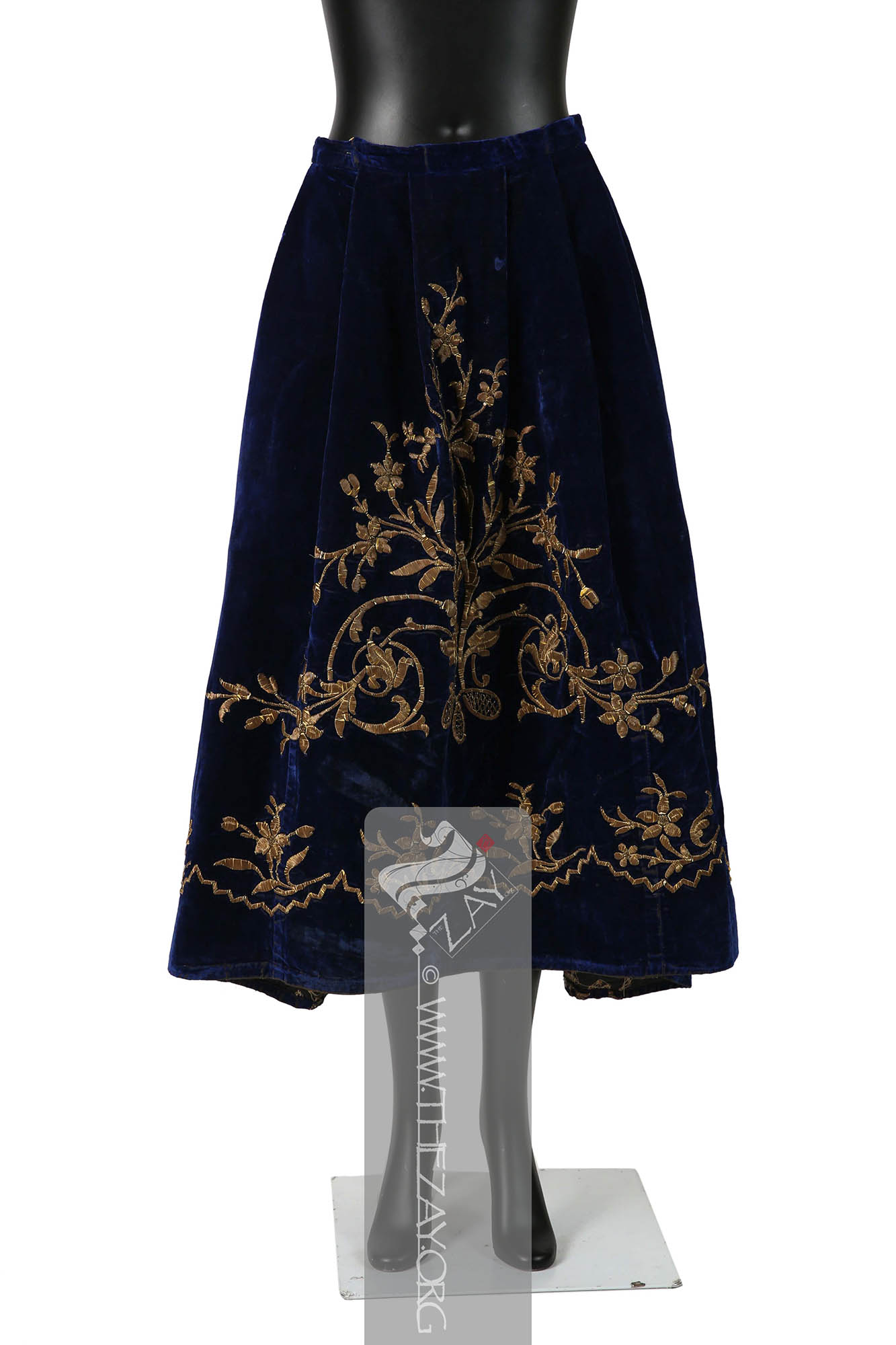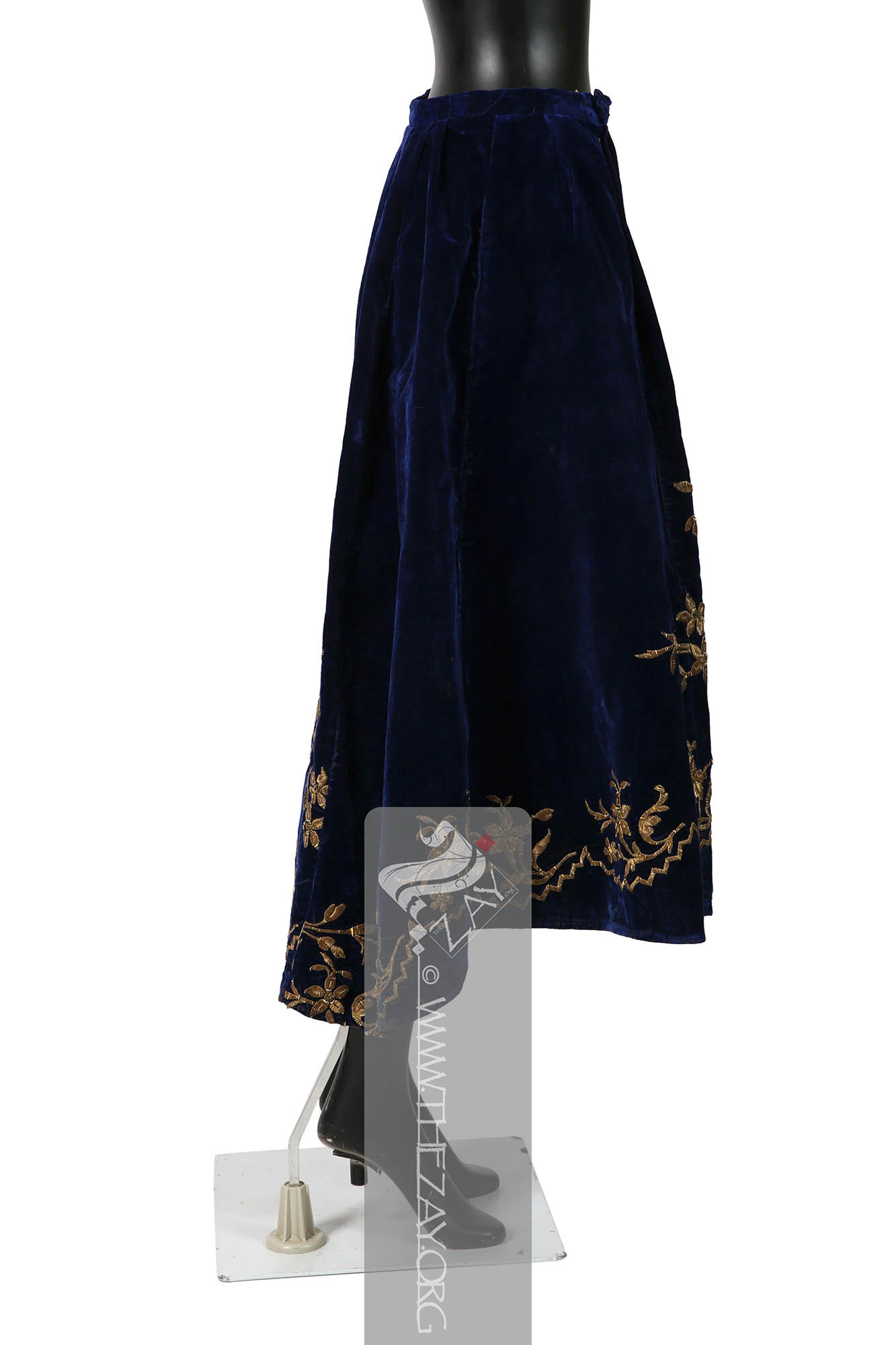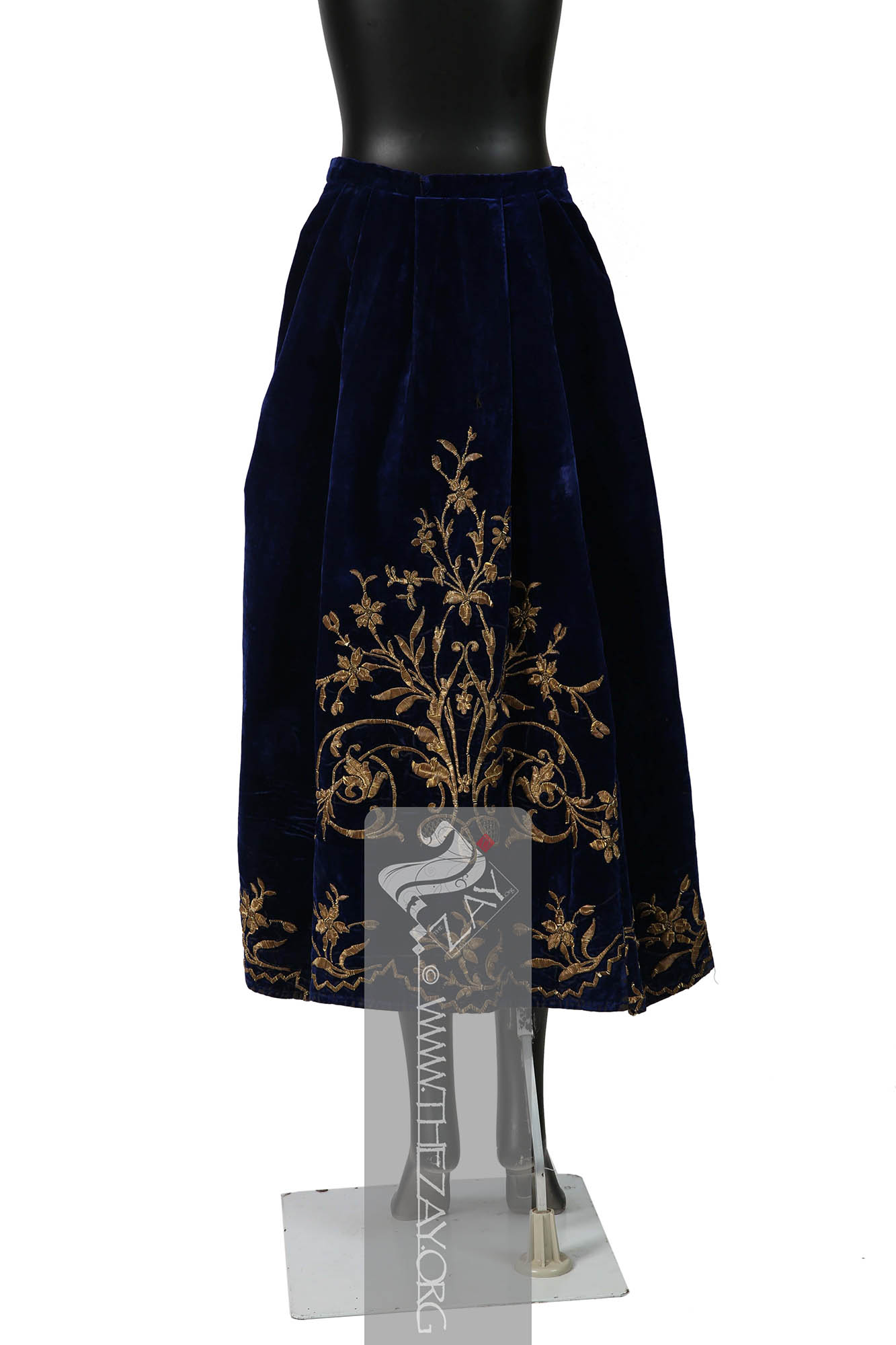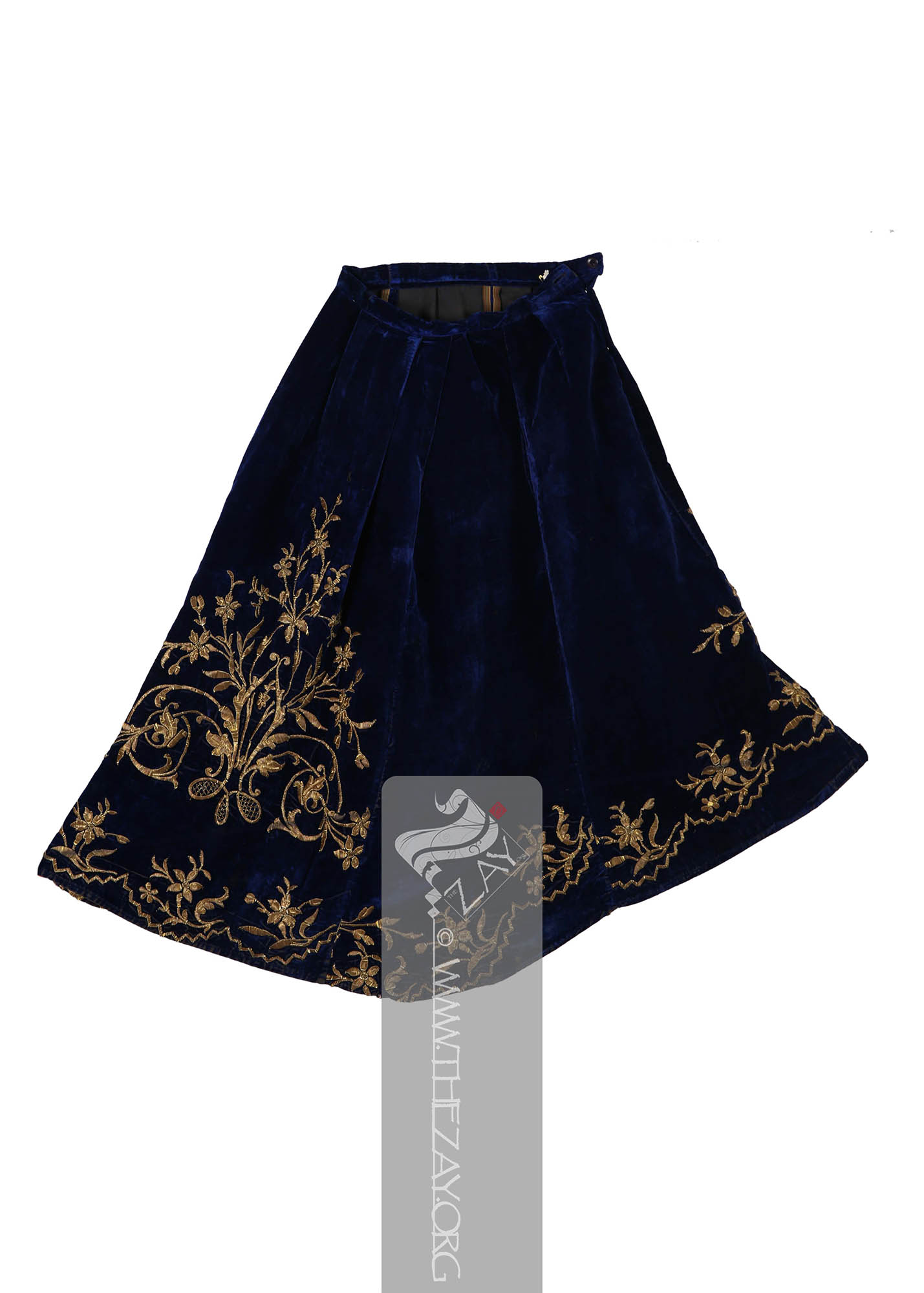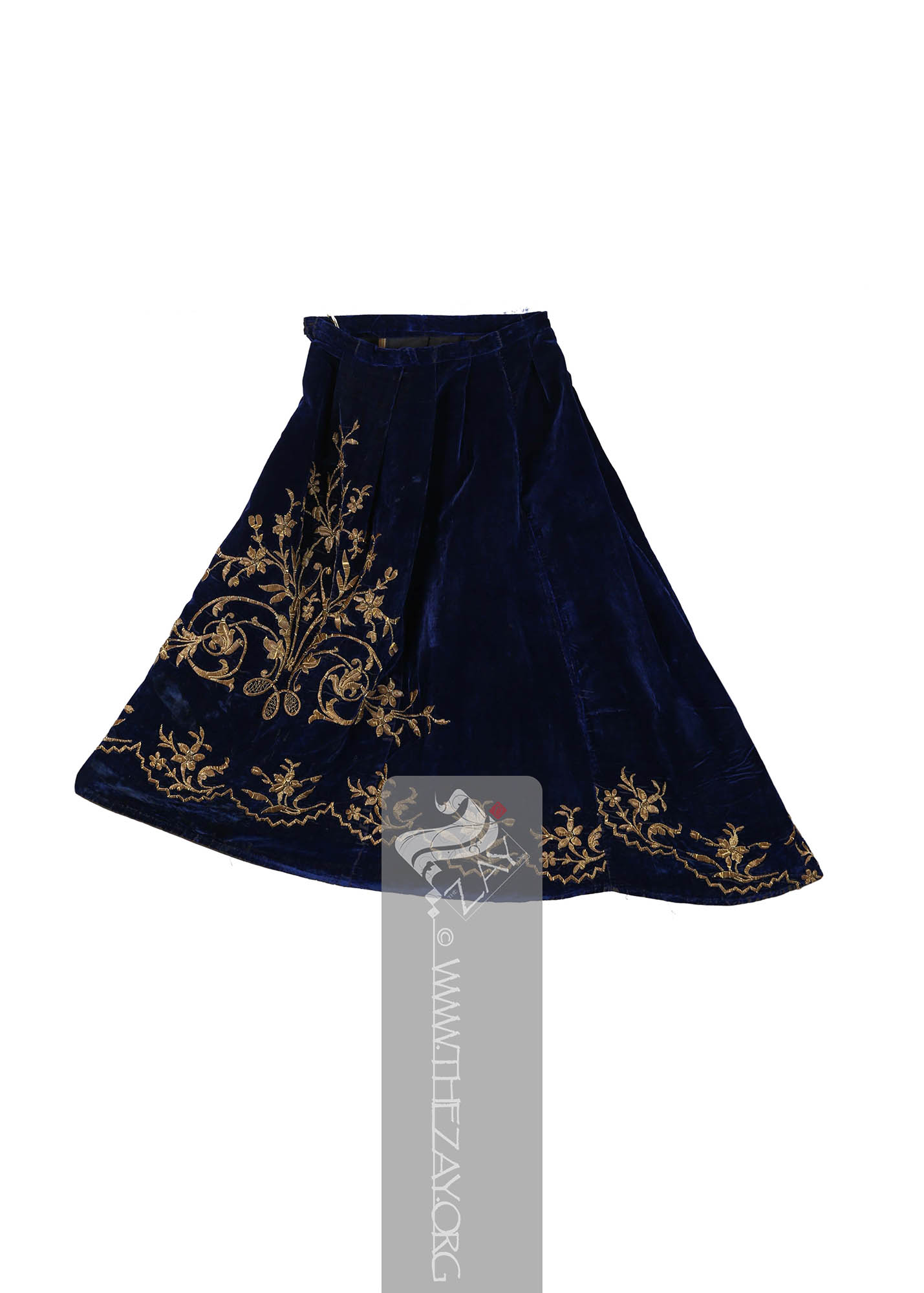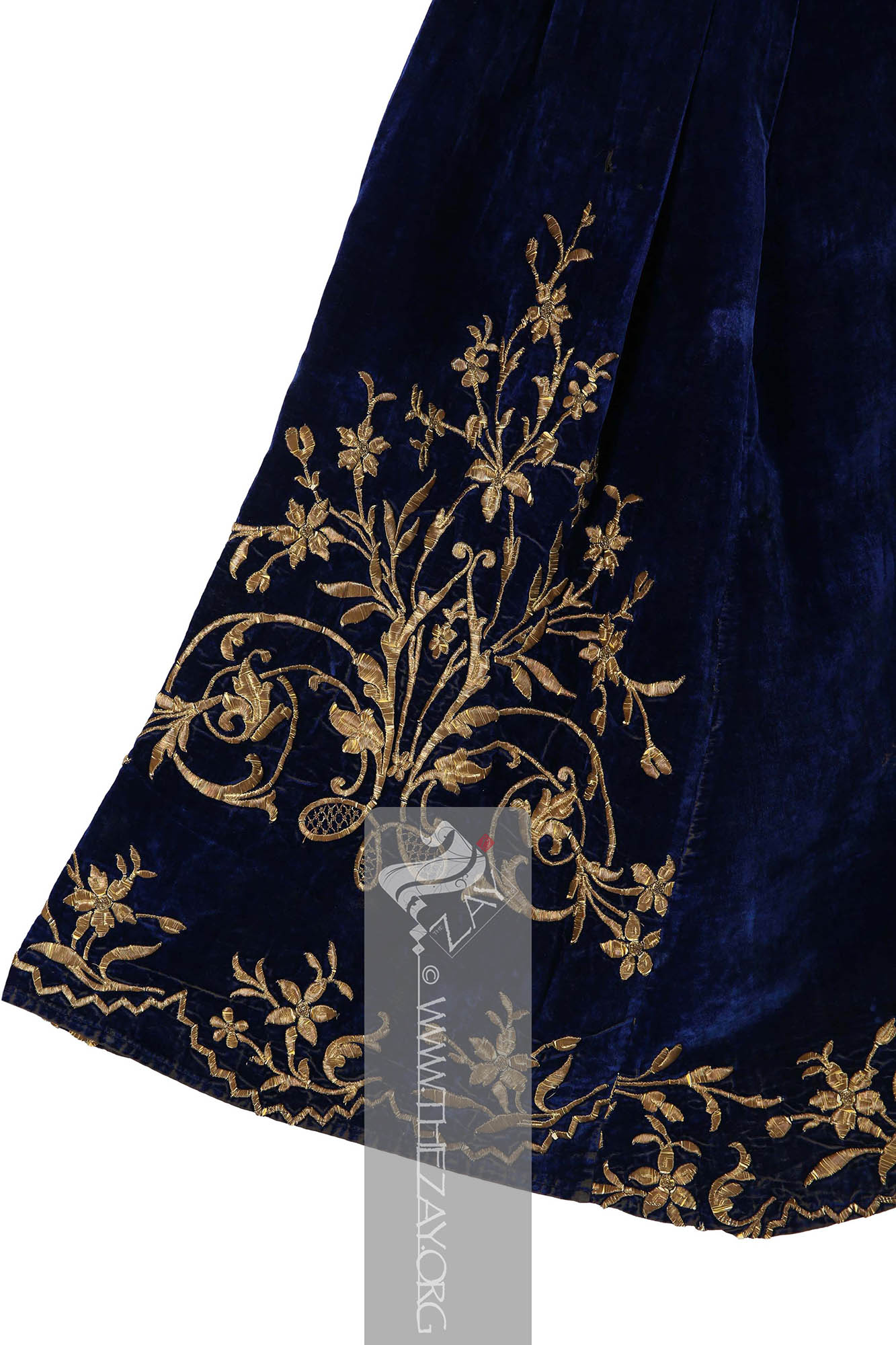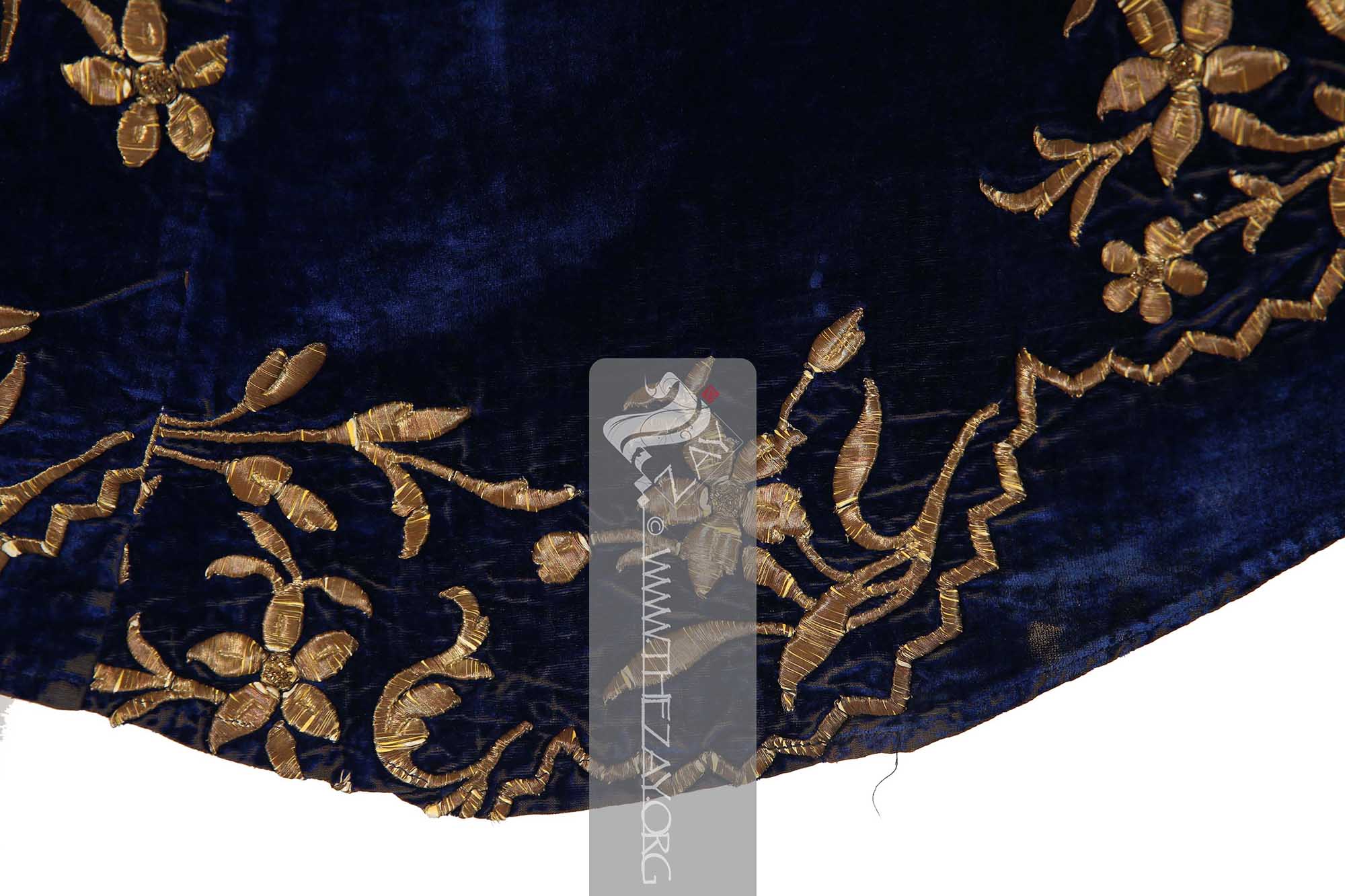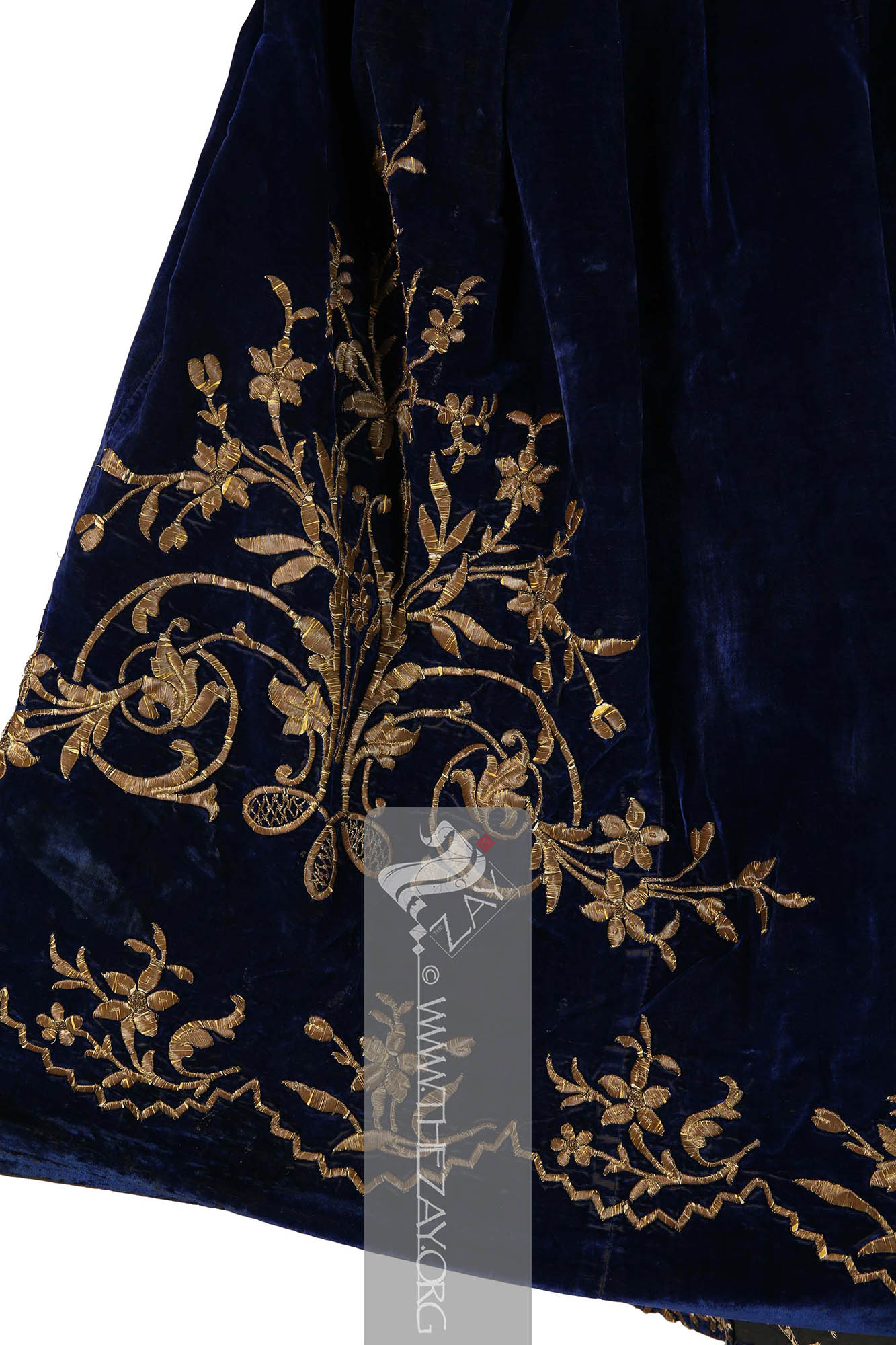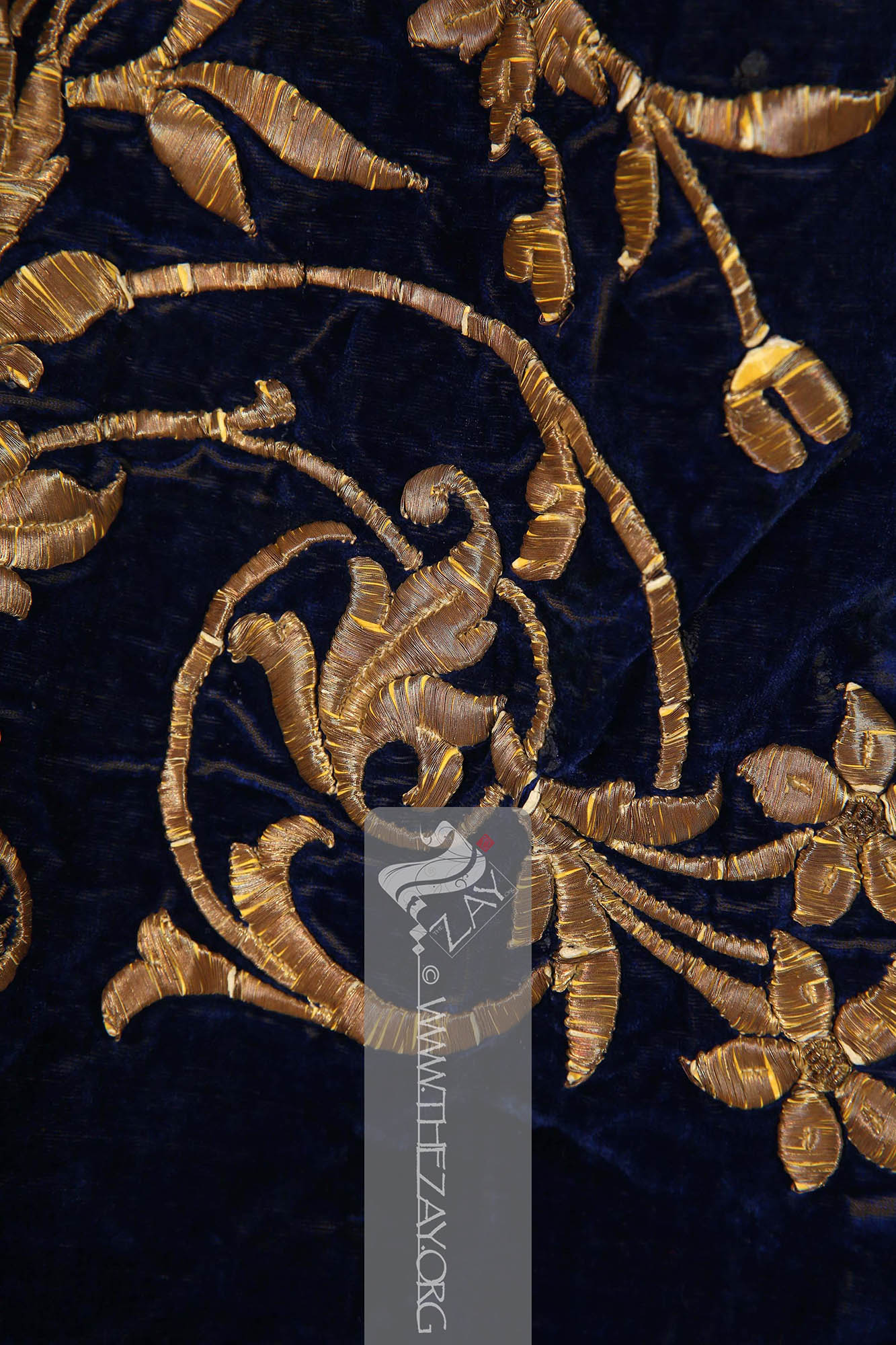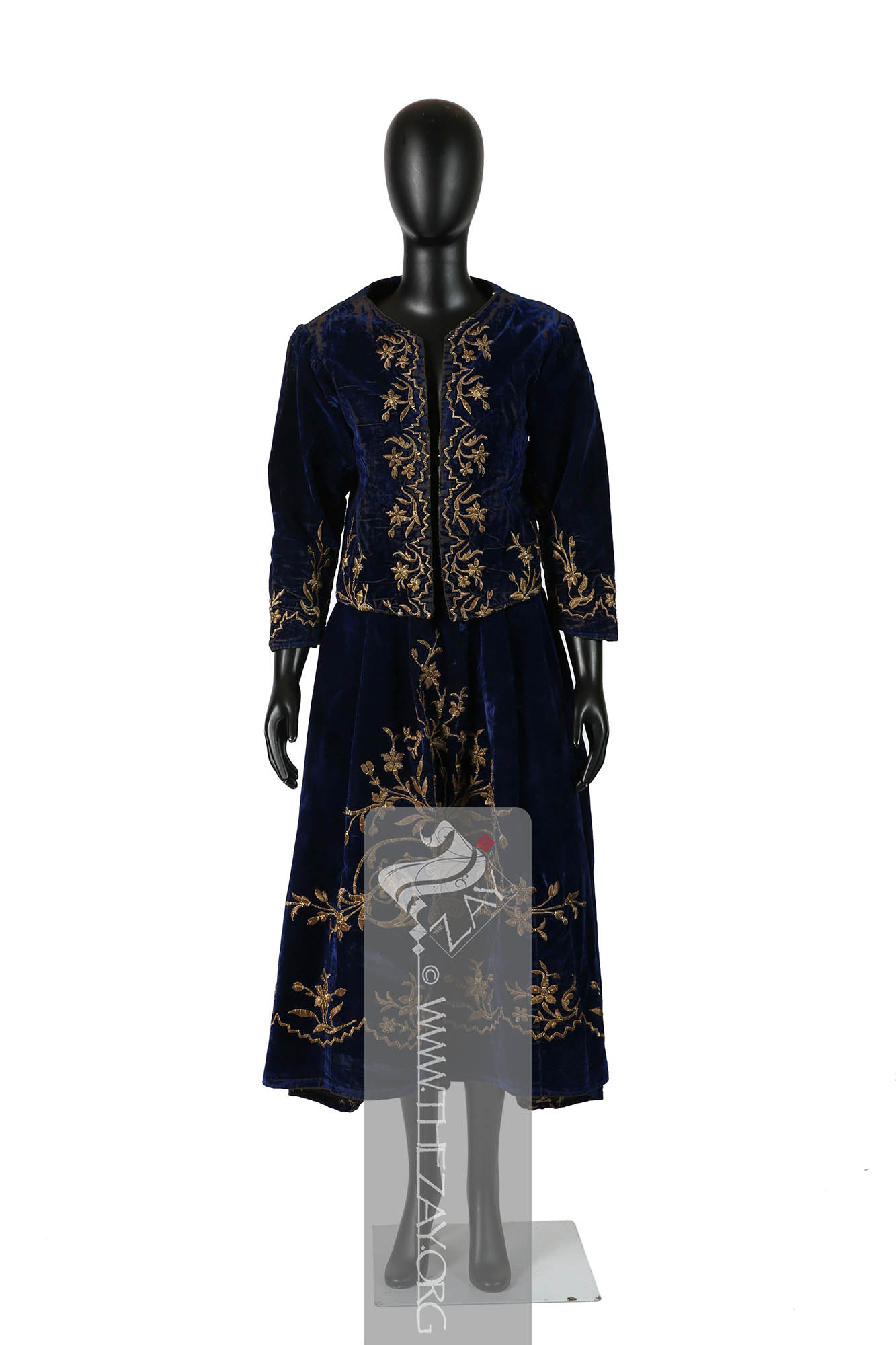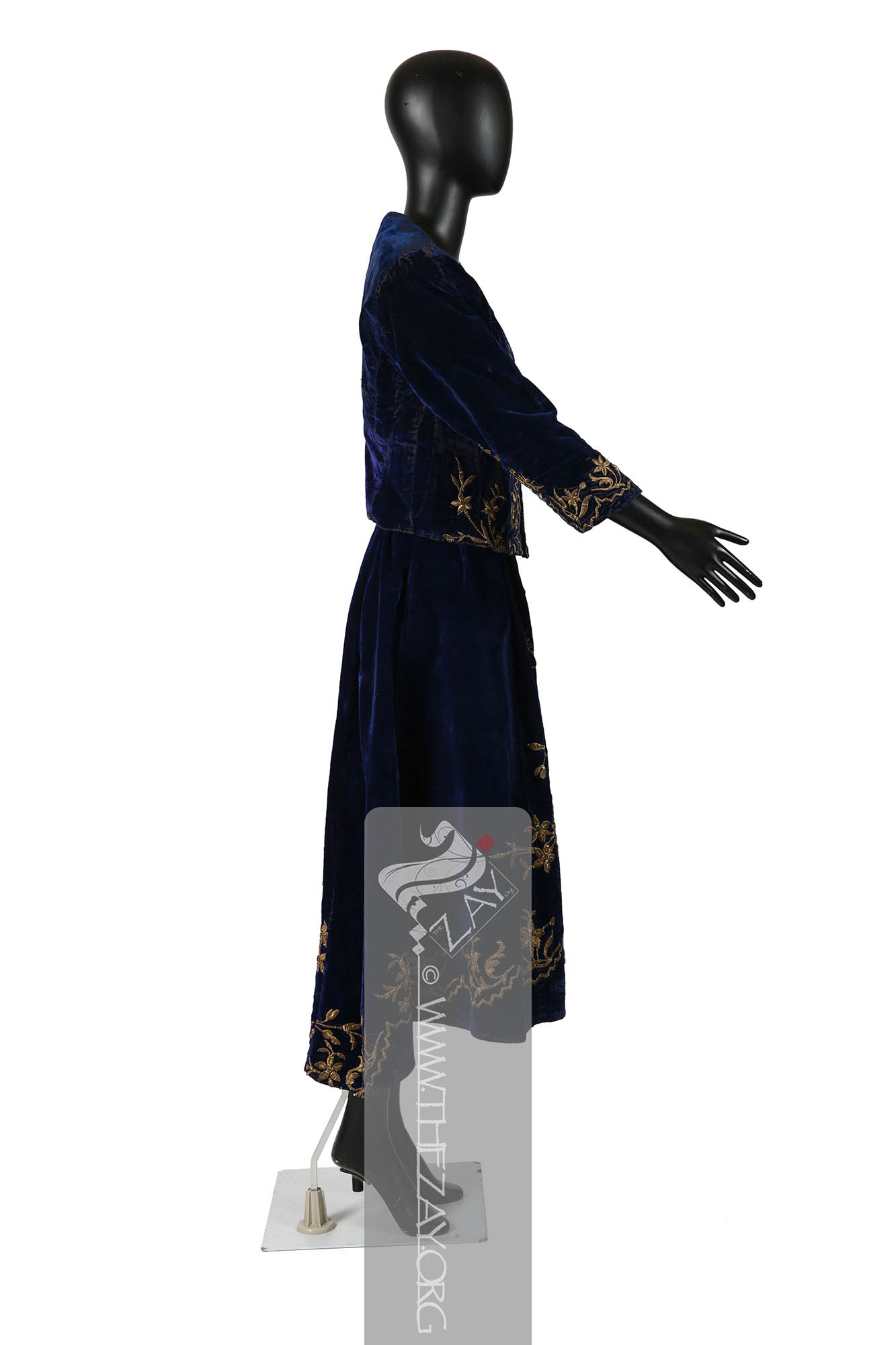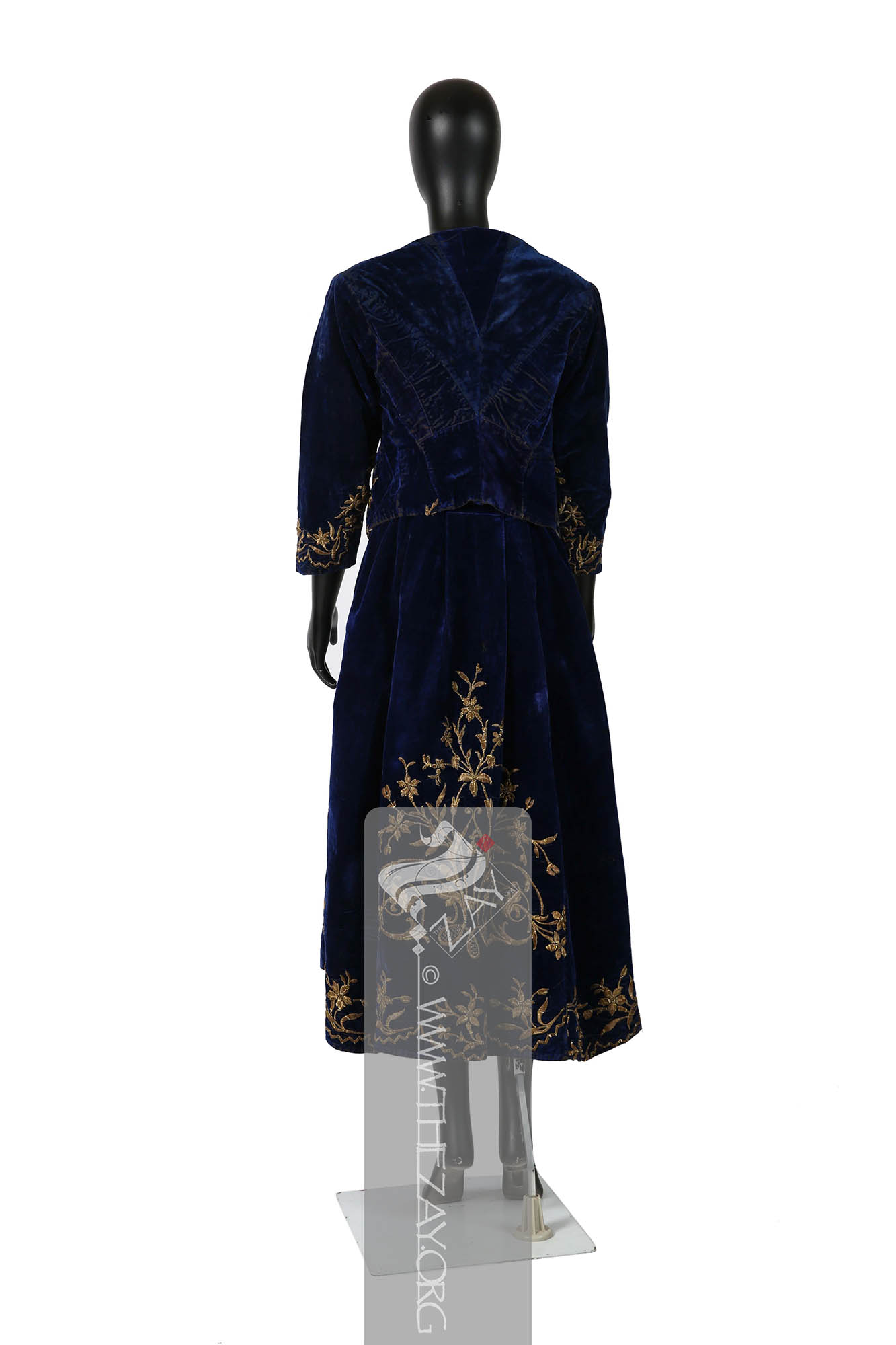Object NotePart of an ensemble with another item also in the collection (
ZI2022.500987 ASIA).
Object History This object was purchased by
Dr. Reem Tariq
Ṭariq: (Arabic; Synonym: tulle_bi_talli
Tūlle_bi_tallī: (French: Tulle – a city in France where fine material for veil was first made; Turkish: tel – wire; Synonym: tariq; talli; badla; khus_dozi ), series of small metal knots made on a woven net ground as embellishment. The term is commonly used in the North African Arab region specifically in Egypt.
; talli; badla; khus_dozi ), series of small metal knots made on a woven net ground as embellishment. The term is commonly used in the Levant Arab region specifically in Lebanon.
El Mutwalli
Dr. Reem Tariq
Ṭariq: (Arabic; Synonym: tulle_bi_talli
Tūlle_bi_tallī: (French: Tulle – a city in France where fine material for veil was first made; Turkish: tel – wire; Synonym: tariq; talli; badla; khus_dozi ), series of small metal knots made on a woven net ground as embellishment. The term is commonly used in the North African Arab region specifically in Egypt.
; talli; badla; khus_dozi ), series of small metal knots made on a woven net ground as embellishment. The term is commonly used in the Levant Arab region specifically in Lebanon.
el Mutwallī: Founder (CEO) of the Zay
Zay: (Arabic: costume, Pl. azyaā’), a set of clothes in a style typical of a particular country or historical period. Initiative, a public figure, speaker and author. An expert curator and consultant in Islamic art and architecture, interior design, historic costume, and UAE heritage. from an independent dealer in London in 2021 to enhance the collection of The
Zay
Zay: (Arabic: costume, Pl. azyaā’), a set of clothes in a style typical of a particular country or historical period. Initiative.
Object Features This is a royal blue silk velvet pleated skirt for women featuring a padded waistband, metal thread embroidered embellishment, and a combination of fastenings. Interestingly this piece dates back to c. early 20th century, a period in the history of the Middle East across the Levant and the Fertile Crescent regions also experienced the popularity of such dresses as it was a part of the Ottoman Empire until the onset of WWI and was thus still heavily influenced by the fashions of Istanbul.
The front field of the skirt is embellished with a floral bouquet executed in traditional Turkish (
dival
Dīval: (Possibly Persian: divan – throne), an embroidery technique prominent during the Ottoman era done with metal threads or wire with a cardboard base usually over velvet. The motif is cut out on a cardboard and the metal thread is then embroidered over it using satin_stitch
Satin_stitch: (Synonym: Damask Stitch), is a type of flat embroidery stitch that creates a satin like smooth and shiny surface by closely spaced stitches, covering an entire area or shape. and gimped couching style embroidery.) style embroidery with brass or copper and silver threads (
sirma
Sirma: (Byzantine Greek: súrma – a dragging motion, from Ancient Greek: súrō – to draw; Synonym: Tel_sirma
Tel_sirma: (Ottoman Turkish: tel – wire, thread, chord; Byzantine Greek: súrma – a dragging motion from Ancient Greek: súrō – to draw; Synonym: Sirma), a metal lace or thread traditionally made of silver or gold and sometimes even copper often used textile embellishments such as embroidery and weaves like brocades. ), a metal lace or thread traditionally made of silver or gold and sometimes even copper often used textile embellishments such as embroidery and weaves like brocades. )/(
tel_sirma
Tel_sirma: (Ottoman Turkish: tel – wire, thread, chord; Byzantine Greek: súrma – a dragging motion from Ancient Greek: súrō – to draw; Synonym: Sirma), a metal lace or thread traditionally made of silver or gold and sometimes even copper often used textile embellishments such as embroidery and weaves like brocades. ).
The design elements comprise European Rococo-inspired wavy vines, flanked by floral and foliage motifs. A combination of different embroidery techniques has been used here primarily (
couching
Couching: (Latin: collocare – Place together), in needlework and embroidery couching is a technique in which yarn or other materials are laid across the surface of the ground fabric and fastened in place with small stitches of the same or a different yarn
) and (
satin_stitch
Satin_stitch: (Synonym: Damask Stitch), is a type of flat embroidery stitch that creates a satin like smooth and shiny surface by closely spaced stitches, covering an entire area or shape.). Similar motifs and elements are repeated at the back of the skirt however, the placement of the central motif is lower than the front.
Similarly, the border in the hemline is higher in the front than in the back. Both front and back hemline features a zigzag base along which floral motifs and foliage patterns are arranged. The embroidery style as well as the motifs of foliage and vine inspired by European Rococo designs suggests that this piece was possibly a pre-embroidered fabric (hüseynî) that was designed for a (
bindalli_entari
Bindallī_entari: (Turkish: bindalli – thousand branches, entari
: (Turkish; Synonym: Antari), a traditional Turkish long jacket-like unisex garment worn during the Ottoman era. It often featured an open front with long sleeves and was worn over an undershirt and a pair of trousers and was sometimes layered by a short waist or hip-length jacket. – a type of traditional Turkish garment; Synonym: thawb_mekhmal
Thawb_mekhmal: (Arabic: thawb – ankle length tunic, mekhmal – velvet; Synonym: bindalli_entari), an ankle-length ceremonial overgarment with a full skirt, small neckline, and straight full sleeves often made of dark-coloured velvet or plush fabric unique for its raised foliage embroidered patterns with vines and branches inspired by European Rococo art. ), an ankle-length ceremonial overgarment with a full skirt, small neckline, and straight full sleeves often made of dark-coloured velvet or plush fabric unique for its raised foliage embroidered patterns with vines and branches inspired by European Rococo art. ).
Although practicing the craft of embroidery was an integral part of women in Ottoman society, pre-embroidered fabrics or hüseynî for garment making had also been around. The last phase of the Ottoman period especially c. late 19th and early 20th century saw the rise of European Rococo-inspired design patterns and motifs.
Such motifs were constantly being adopted and featured on textiles throughout the Empire, especially for the embellishment of ceremonial garments reserved for weddings and other important occasions.
More InfoThe
dival
Dīval: (Possibly Persian: divan – throne), an embroidery technique prominent during the Ottoman era done with metal threads or wire with a cardboard base usually over velvet. The motif is cut out on a cardboard and the metal thread is then embroidered over it using satin_stitch
Satin_stitch: (Synonym: Damask Stitch), is a type of flat embroidery stitch that creates a satin like smooth and shiny surface by closely spaced stitches, covering an entire area or shape. and gimped couching style embroidery. technique is a complex and intricate form of embroidery involving multiple processes, from pattern preparation to final execution. It requires carving the pattern from artificial leather with a special knife, neatly cutting it, and supporting it with thick cardboard on a special loom.
The top is then embroidered with metal thread or
sirma
Sirma: (Byzantine Greek: súrma – a dragging motion, from Ancient Greek: súrō – to draw; Synonym: Tel_sirma
Tel_sirma: (Ottoman Turkish: tel – wire, thread, chord; Byzantine Greek: súrma – a dragging motion from Ancient Greek: súrō – to draw; Synonym: Sirma), a metal lace or thread traditionally made of silver or gold and sometimes even copper often used textile embellishments such as embroidery and weaves like brocades. ), a metal lace or thread traditionally made of silver or gold and sometimes even copper often used textile embellishments such as embroidery and weaves like brocades. in 3 or 6 layers, while the bottom is bonded with fabric-coloured thread that is waxed. This labour-intensive process resembles Turkish wrapping on the front and crocheting in reverse.
A unique feature of this embroidery is that the upper thread is invisible from the bottom. The technique is often referred to as "Maraş work" due to its extensive application in Kahramanmaraş.
Initially crafted by hand, modern advancements have led to machine-produced
dival
Dīval: (Possibly Persian: divan – throne), an embroidery technique prominent during the Ottoman era done with metal threads or wire with a cardboard base usually over velvet. The motif is cut out on a cardboard and the metal thread is then embroidered over it using satin_stitch
Satin_stitch: (Synonym: Damask Stitch), is a type of flat embroidery stitch that creates a satin like smooth and shiny surface by closely spaced stitches, covering an entire area or shape. and gimped couching style embroidery. embroidery, which is more cost-effective. The fabric materials used for
dival
Dīval: (Possibly Persian: divan – throne), an embroidery technique prominent during the Ottoman era done with metal threads or wire with a cardboard base usually over velvet. The motif is cut out on a cardboard and the metal thread is then embroidered over it using satin_stitch
Satin_stitch: (Synonym: Damask Stitch), is a type of flat embroidery stitch that creates a satin like smooth and shiny surface by closely spaced stitches, covering an entire area or shape. and gimped couching style embroidery. embroidery include velvet,
satin
Sātin: (Arabic: Zaytuni: from Chinese port of Zayton in Quanzhou province where it was exported from and acquired by Arab merchants), one of the three basic types of woven fabric with a glossy top surface and a dull back. Originated in China and was fundamentally woven in silk., leather, silk, and
taffeta
Taffeta: (Persian: tāftan – to shine), a plain woven fabric with a crisp and smooth finish and feel on both sides traditionally woven with silk yarns. Traditionally, taffeta fabric has been known for making European women’s court dress especially and became particularly famous under the patronage of Madame de Pompadour.
and vary in cost based on their pattern size and processing technique.
At its peak, the Ottoman Empire spanned three continents and served as the crossroads between the East and the West – the Fertile Crescent, the Levant, Eastern Europe including the Balkans till the southern edge of the Great Hungarian Plain, Northern Africa, and Eastern Mediterranean.
After the conquest of the Arab world in c. 1516-1517 CE its control over the Middle East lasted for four centuries until the early 20th century with the onset of WW I and the Arab Revolt.
These four hundred years witnessed many instances of mutual Arab and Ottoman cultural influences and exchanges.
Through areas such as social life and art – decorative and performing –we come across several instances of Arab and Turkish culture blending together through the centuries.
Just as European fashion was often inspired by the French court this socio-cultural blending between Ottoman Turkey and the Middle East was clearly reflected in its fashion and material culture.
Thus, while emulating Ottoman fashion as the mark of class in the Arab world was one side of the puzzle adapting Eastern European fashion particularly Balkan as part of mainstream couture culture because of the sizeable Balkan population within the Empire was another. Therefore, it is not surprising to find several articles of clothing and their terms similar between these cultures.
As such The
Zay
Zay: (Arabic: costume, Pl. azyaā’), a set of clothes in a style typical of a particular country or historical period. Initiative has in its possession pieces that were constructed in a similar style that was sourced from the Levant region of the Arab world, especially Palestine and Syria. Velvet pieces such as this embellished with
dival
Dīval: (Possibly Persian: divan – throne), an embroidery technique prominent during the Ottoman era done with metal threads or wire with a cardboard base usually over velvet. The motif is cut out on a cardboard and the metal thread is then embroidered over it using satin_stitch
Satin_stitch: (Synonym: Damask Stitch), is a type of flat embroidery stitch that creates a satin like smooth and shiny surface by closely spaced stitches, covering an entire area or shape. and gimped couching style embroidery. style embroidery were often used for ceremonial purposes especially weddings by the women of the Arab world and were often colloquially known as the velvet robe or (
thawb_mekhmal
Thawb_mekhmal: (Arabic: thawb – ankle length tunic, mekhmal – velvet; Synonym: bindalli_entari), an ankle-length ceremonial overgarment with a full skirt, small neckline, and straight full sleeves often made of dark-coloured velvet or plush fabric unique for its raised foliage embroidered patterns with vines and branches inspired by European Rococo art. ).
Links
- Cangökçe, Hadiye, et al. Osmanlı İmparatorluğu’nun Son Döneminden Kadın Giysileri = Women’s Costume of the Late Ottoman Era from the Sadberk Hanım Museum Collection. Sadberk Hanım Museum, 2010.
- Küçükerman, Önder, and Joyce Matthews. The Industrial Heritage of Costume Design in Turkey. GSD Foreign Trade Co. Inc, 1996.
- AĞAÇ, Saliha, and Serap DENGİN. “The Investigation in Terms of Design Component of Ottoman Women Entari
: (Turkish; Synonym: Antari), a traditional Turkish long jacket-like unisex garment worn during the Ottoman era. It often featured an open front with long sleeves and was worn over an undershirt and a pair of trousers and was sometimes layered by a short waist or hip-length jacket. in 19th Century and Early 20th Century.” International Journal of Science Culture and Sport (IntJSCS), vol. 3, no. 1, Mar. 2015, pp. 113–125. https://dergipark.org.tr/tr/download/article-file/91778
- Parker, Julianne. “OTTOMAN AND EUROPEAN INFLUENCE IN THE NINTEENTH-CENTURY BRIDAL COLLECTION OF THE AZEM PALACE, DAMASCUS, SYRIA.” Journal of Undergraduate Research: Brigham Young University, 18 Sept. 2013. http://jur.byu.edu/?p=6014
- Koç, Adem. “The Significance and Compatibility of the Traditional Clothing-Finery Culture of Women in Kutahya in Terms of Sustainability.” Milli Folklor , vol. 12, no. 93, Apr. 2012. 184. https://www.millifolklor.com/PdfViewer.aspx?Sayi=93&Sayfa=181
- Micklewright, Nancy. “Late-Nineteenth-Century Ottoman Wedding Costumes as Indicators of Social Change.” Muqarnas, vol. 6, 1989, pp. 161–74. JSTOR, https://doi.org/10.2307/1602288. Accessed 13 July 2023.
- Micklewright, Nancy. “Looking at the Pst: Nineteenth Century Images of Constantinople and Historic Documents.” Expedition, vol. 32, no. 1, pp. 24–32. https://www.penn.museum/documents/publications/expedition/pdfs/32-1/micklewright.pdf
- ÇATALKAYA GÖK, Ebru. “Çi̇tari̇Fabric.” TURKISH ONLINE JOURNAL OF DESIGN ART AND COMMUNICATION, vol. 11, no. 2, 2021, pp. 443–453, https://doi.org/10.7456/11102100/008.
- Ozgen, Ozlen, et al. “Henna Ritual Clothing in Anatolia from Past to Present: An Evaluation on Bindalli.” Textile Society of America Symposium Proceedings, 2021, https://doi.org/10.32873/unl.dc.tsasp.0122.
- https://artsandculture.google.com/story/traditional-jewellery-and-dress-from-the-balkans-the-british-museum/ZQXB8B6bvfnaKw?hl=en
- https://www.issendai.com/16thcenturyistanbul/womens-garb-piece-by-piece/yelek
Yelek: (Old Anatolian: yélek – Vest; Synonyms: Jelick, Jilek), short waist or hip length vest traditionally worn by both Ottoman men and women throughout the empire. Ranging from sleeveless to full sleeves, these vests were usually front open and without any fastenings. Often cepken jackets were used as yelek. -kurdiye-cuka-kurk-overcoats/
- https://www.metmuseum.org/art/collection/search/126821
- https://archive.aramcoworld.com/issue/200703/the.skill.of.the.two.hands.htm
- http://www.turkishculture.org/textile-arts/clothing/womens-garments/womens-garments-1065.htm?type=1
- http://jezebeljane.blogspot.com/2015/09/womens-clothing-in-16th-century-turkey.html
- https://www.issendai.com/16thcenturyistanbul/visual-dictionary/kaftan/
- https://babogenglish.wordpress.com/2016/02/25/turkey-general-information/
- https://ertugrulforever.com/turkish-fashion-2021/
- https://northamericaten.com/turkish-clothing-of-ottoman-times/
- https://www.al-monitor.com/originals/2019/04/turkish-traditional-costumes-from-head-to-toe.html
- https://reconstructinghistory.com/blogs/blog/an-ottoman-turkish-outfit-part-iii-the-yelek
Yelek: (Old Anatolian: yélek – Vest; Synonyms: Jelick, Jilek), short waist or hip length vest traditionally worn by both Ottoman men and women throughout the empire. Ranging from sleeveless to full sleeves, these vests were usually front open and without any fastenings. Often cepken jackets were used as yelek.




